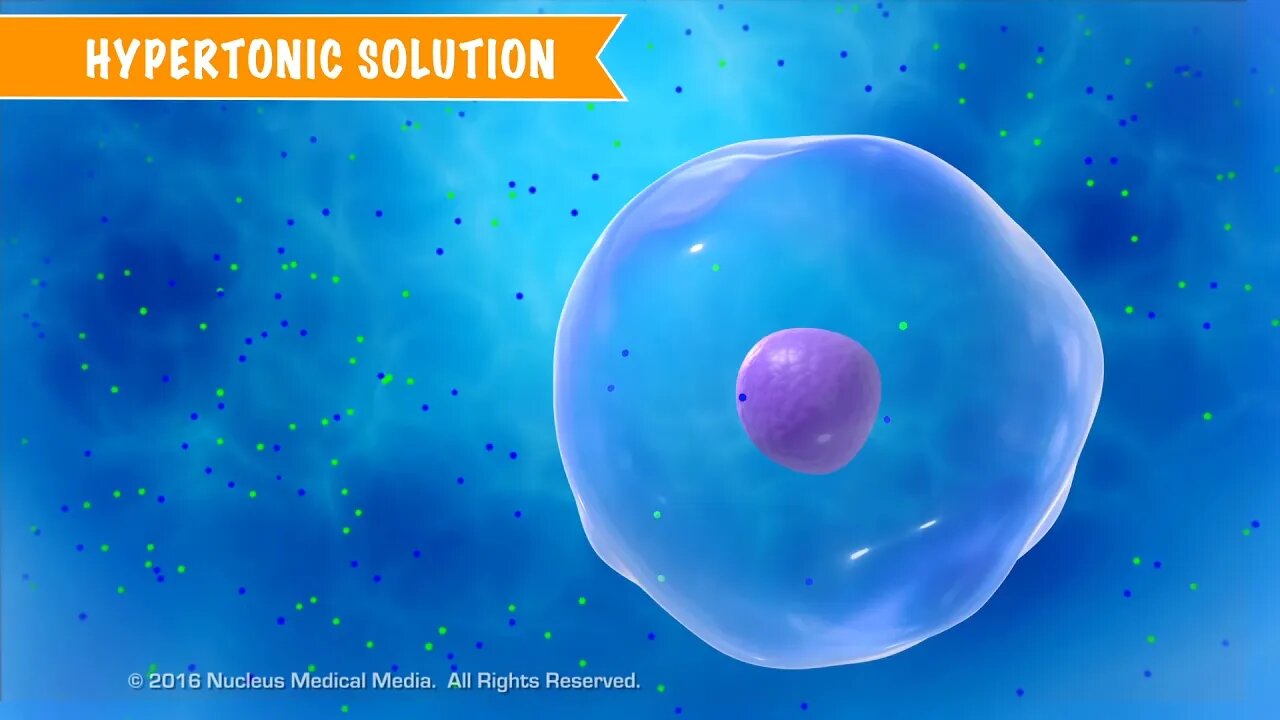Premium Only Content

Cell Transport and Solutions
For Employees of hospitals, schools, universities and libraries: download up to 8 FREE medical animations from Nucleus by signing up for a free trial at: http://nmal.nucleusmedicalmedia.com/biology_youtube
#CellTransport #CellSolutions #biology
SCIENCE ANIMATION TRANSCRIPT: In this video, we'll discuss cell transport and solutions. The concentration gradient of extracellular solutions affects the transport of substances through the cell membrane. What can happen in this process? Well, cells may be surrounded by solutions with different particle concentrations, both in a lab as well as inside a living organism. So we need to know how cells will respond. Compared to the solution inside a cell, a solution outside the cell may be hypertonic, isotonic, or hypotonic. We'll describe hypertonic solutions using this beaker of water with dissolved salt, and a rather large cell submerged in it. To demonstrate water movement in and out of cells, we'll use simple numbers to illustrate concepts. Remember, the cell cytoplasm is mostly water as well. In this example, let's say the cytoplasm inside the cell is a solution containing 10% salt, which means the other 90% is water. Keep in mind percentages of substances within the cell must equal 100%. The percentages of solute and solvent in the beaker must also add up to 100%. However, the solution in the beaker is a different concentration from the solution inside the cell. It's 20% salt and 80% water. So you can see that there's a greater concentration of water inside the cell than outside, 90% compared to 80%. We call a solution hypertonic when its concentration of water is lower than inside the cell and its concentration of solute is higher than inside the cell. As a result, water molecules diffuse out of the cell through osmosis, causing the cell to shrivel a bit. Remember, osmosis means diffusion of water. If the solution's water concentration was significantly lower, the cell could shrivel to the point of imploding. For red blood cells in hypertonic solutions, the shriveling from osmotic water loss is called crenation. Let's look at an example of plant cells in a hypertonic solution. Normally, turgor pressure, which is the water pressure in a plant cell's central vacuole, helps support the cell wall and overall plant shape. When water leaves plant cells by osmosis, the cell membrane and its contents shrink away from the rigid cell wall, and turgor pressure decreases. This is called plasmolysis. Plasmolysis causes a plant to wilt. Let's look at another container, this time with a cell floating in an isotonic solution. Sometimes, the solution outside the cell has about the same concentration gradient as the concentration gradient inside the cell. Once again, in this example, the solution inside the cell is 90% water with 10% salt, but this time, the surrounding solution is also 90% water with 10% salt dissolved. We call a solution isotonic when its concentrations of water and solute are the same as inside the cell. But this doesn't mean that there is no movement. In an isotonic solution, the rate of water molecules entering the cell is equal to the rate of water molecules exiting the cell. The amount of water molecules going in equals the amount of water molecules going out. That's why you see the arrows pointing in two different directions. In an isotonic solution, the cell doesn't shrink or swell. It stays exactly the same size. A third possibility is a solution outside the cell with a higher concentration of water than the solution inside the cell. In this example, the solution inside the cell has 20% salt. So that means the remainder is 80% water, but the cell has been placed in a beaker that only has a 10% salt solution. Doing the math, we can see that the solution surrounding the cell is 90% water, which means there's a greater concentration of water outside the cell than inside. We call a solution hypotonic when its concentration of water is higher than inside the cell, and its concentration of solute is lower than inside the cell. So by osmosis, the water molecules will move passively into the cell until a state of equilibrium is reached. Hypotonic solutions cause a cell to swell up with water. If the water concentration outside the cell is high enough, the cell can swell to the point of bursting. This is called cytolysis. Cytolysis in red blood cells is called hemolysis. Cytolysis doesn't happen in plant cells because the rigid cell wall prevents the cells from bursting. Here's a little trick to remember that hypotonic solutions cause a cell to swell rather than shrivel. When you think of hypo, think of a big, swollen hippopotamus or hippo for short. So to recap, we can have solutions that are hypertonic, isotonic, or hypotonic with respect to the cell. In an isotonic solution, the water concentration inside and outside the cell stays about the same. The water concentration stays the same because the concentration of solute is the same...
NSV15018
-
 52:07
52:07
BonginoReport
5 hours agoThe Internet Picks Bongino’s FBI Replacement - Nightly Scroll w/ Hayley Caronia (Ep.200)
81.3K52 -
 55:30
55:30
Russell Brand
6 hours agoStay Free LIVE from AmFest — Turning Point USA - SF665
116K14 -
 1:11:26
1:11:26
Kim Iversen
7 hours agoTrump Pulls War Fake-Out…Attack on Venezuela Still Coming!?
75.7K96 -
 2:04:53
2:04:53
Redacted News
6 hours agoPutin just changed EVERYTHING with this move and NATO can't do anything | Redacted w Clayton Morris
168K130 -
 25:22
25:22
DeVory Darkins
6 hours agoTrump scores MAJOR WIN after Inflation Report as his speech sparks EPIC MELTDOWN
53.2K51 -
 1:01:23
1:01:23
Nick Freitas
7 hours agoLIVE at America Fest!
68.5K3 -
 1:11:19
1:11:19
vivafrei
7 hours agoCandace Owens' Backtracks? Brown University Cover-Up? Bongino Leaves! Pfizer Makes LEGAL ADMISSIONS?
148K78 -
![[Ep 813] LIVE from Rumble Set at AmFest 2025 | Guests Vem, Midnight, & Kevin Smith](https://1a-1791.com/video/fwe2/31/s8/1/4/F/c/J/4FcJz.0kob-small-Ep-813-LIVE-from-Rumble-Set.jpg) 56:22
56:22
The Nunn Report - w/ Dan Nunn
8 hours ago[Ep 813] LIVE from Rumble Set at AmFest 2025 | Guests Vem, Midnight, & Kevin Smith
60.9K4 -
 29:58
29:58
Stephen Gardner
8 hours ago🔥IT'S BAD! NEW report just DROPPED!
59.2K45 -
 13:09:07
13:09:07
LFA TV
23 hours agoLIVE & BREAKING NEWS! | THURSDAY 12/18/25
221K17